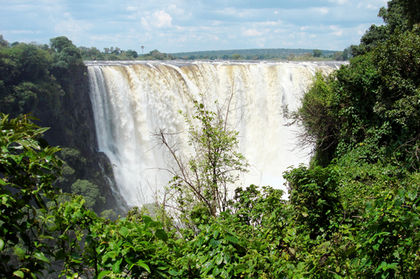ZIMBABWE

Republic of Zimbabwe
COUNTRY OVERVIEW
LOCATION AND SIZE.
The Republic of Zimbabwe is a landlocked country in southern Africa, covering an area of 390,757 square kilometers (150,872 square miles), of which land occupies 386,670 square kilometers (1,929 square miles), and water occupies 3,910 square kilometers (1,509 square miles). Zimbabwe is bounded on the north and northwest by Zambia (797 kilometers), southwest by Botswana (813 kilometers), Mozambique (1,231 kilometers) on the east, South Africa (225 kilometers) on the south, and Namibia's Caprivi Strip touches its western border at the intersection with Zambia. The country is slightly larger than Montana.
Zimbabwe sits astride the high plateaus between the Zambezi and Limpopo rivers, its main drainage systems. Much of the country is elevated, 21 percent being more than 1,200 meters (3,937 feet) above sea level. The topography consists of 4 relief regions. The high veld (an open, grassy expanse) rises above 1,200 meters and extends across the country from the northeast narrowing towards the southwest. The middle veld, lying between 900 and 1,200 meters (2,953 and 3,937 feet) above sea level, flanks the high-veld, mostly extending towards the northwest. The low veld stands below 900 meters (2,953 feet) and occupies the Zambezi basin in the north and the more extensive Limpopo and Sabi-Lundi basins in the south and southeast. The eastern highlands have a distinctive mountainous character, rising above 1,800 meters (5,906 feet), and include Mount Inyangani (sometimes called simply Inyangani), standing at 2,592 meters (8,504 feet) above sea level.
POPULATION.
The census of 1992 indicated a population of 10.41 million, and by mid-2000 the estimate was 11.34 million. The population has been growing at a rate estimated at 2.6 percent a year from 1990 to date, and this implies a fertility rate of 3.8 children per woman. The population is youthful, with only 3.5 percent over the age of 65, 39.6 percent in the 0 to 14 age group, and 56.8 percent in the 15 to 64 age group.
The country's population is diverse and was estimated in the mid-1980s to include—besides the indigenous people—some 223,000 people of European descent as well as 37,000 Asians and people of mixed ethnic backgrounds—all of them the legacy of the colonial era. The indigenous people accounted for more than 98 percent of the population in the mid-1997 estimates, and were comprised mostly of 2 broad ethnic or linguistic groups: the Ndebele and Shona. The Shona comprised 71 percent and Ndebele 16 percent of the population in 1997. There are, in addition, several other minor ethnic groups such as the Hlengwe, Sena, Sotho, Tonga, and Venda who constituted the other 11 percent. English, Shona, and Sindebele are the official languages universally taught in schools.
Urban growth has been rapid in recent years. Over the 1982-92 period, the population of Harare, the capital, is reported to have almost doubled from 656,000 to 1,189,103, while that of Bulawayo, the second-largest
DEPENDENCIES
Zimbabwe has no territories or colonies.
BIBLIOGRAPHY
Economist Intelligence Unit. Country Profile: Zimbabwe. London: Economist Intelligence Unit, 2001.
Embassy of Zimbabwe. <http://www.zimembassy-usa.org> .Accessed October 2001.
Green, Richard, editor. Commonwealth Yearbook. London: HerMajesty's Stationery Office, 2000.
Hodd, M. "Zimbabwe." In The Economies of Africa. Aldershot:Dartmouth, 1991.
U.S. Central Intelligence Agency. World Factbook 2000. <http://www.odci.gov/cia/publications/factbook/geos/zi.html> . Accessed December 2000.
U.S. Central Intelligence Agency. World Factbook 2001. <http://www.odci.gov/cia/publications/factbook/index.html> . Accessed October 2001.
World Bank. World Bank Africa Database 2000. Washington DC: World Bank, 2000.
ZDNews.com . "Zimbabwe's Troubled Tourist Industry." <http://www.zwnews.com/issuefull.cfm?ArticleID=37> . Accessed September 2001.
"Zimbabwe." In Africa South of the Sahara. London: Europa Publications, 2000.
—Allan C. K. Mukungu
CAPITAL:
Harare.
MONETARY UNIT:
Zimbabwe Dollar (Z$). Z$1 equals 100 cents. Coins are in denominations of 1, 5, 10, 20, and 50 cents and Z$1 and 2. Paper currency is in denominations of Z$2, 5, 10, 20, 50, and 100.
CHIEF EXPORTS:
Tobacco, gold, ferro-alloys, nickel, cotton, clothing, textiles, agricultural food crops.
CHIEF IMPORTS:
Machinery, transport equipment, manufactured goods, chemicals, fuels.
GROSS DOMESTIC PRODUCT:
US$28.2 billion (purchasing power parity, 2000 est.).
BALANCE OF TRADE:
Exports: US$1.8 billion (f.o.b., 2000 est.). Imports: US$1.3 billion (f.o.b., 2000 est.).